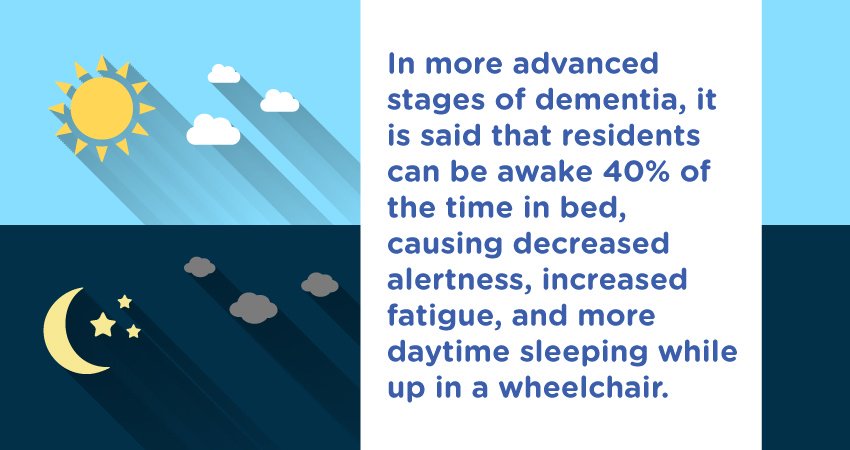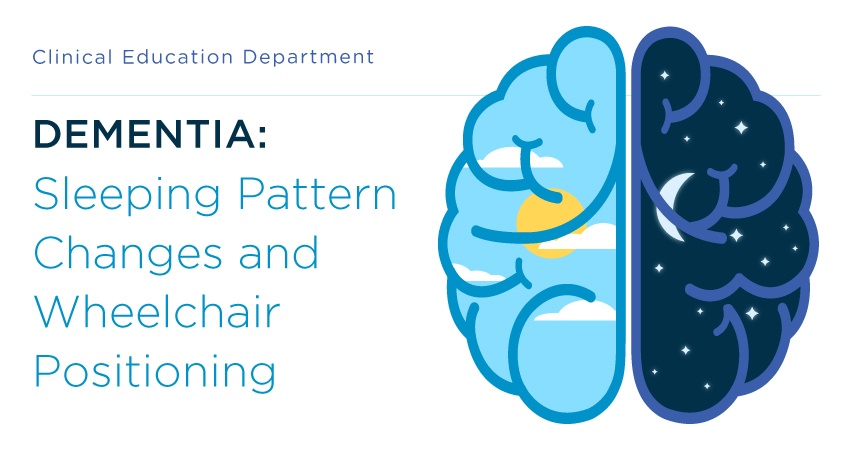Part 7 in our series on Dementia. Check out Part 1, Part 2, Part 3, Part 4, Part 5, and Part 6.
When damage to the brainstem occurs in residents with dementia, they may see a change in the sleep-wake cycle and experience autonomic nervous system dysfunction. In both instances, the resident is placed at risk for serious health issues when positioned incorrectly in a seating system.
Residents with dementia experience changes in sleeping patterns that cause:
- A disruption in the deep sleep phase and REM cycle
- Decreased alertness
- Fatigue
- Insomnia and other sleep disorders
If that wasn’t enough, our residents are faced with yet another challenge as brainstem damage compromises the autonomic nervous system as well.
Autonomic dysfunction may include:
- Irregularities in heart rate
- Irregularities in respiration
- Difficulty controlling blood pressure
- Digestive issues resulting in a loss of appetite, weight loss or gain
- Inability to regulate temperature changes
Residents begin to sleep in their chair as a result of the changes in sleeping patterns. In more advanced stages of dementia, it is said that residents can be awake 40% of the time in bed, causing decreased alertness, increased fatigue, and more daytime sleeping while up in a wheelchair. There is a greater tendency to slouch over, slide down, and lean while sleeping in the chair, which causes constriction to the chest and abdomen. This issue can be very serious if we do not learn to position a resident correctly. We must work toward postures that will not add further constriction to the chest or abdomen of an already compromised system.

When the chest and abdomen is constricted:
-
The diaphragm cannot contract properly
-
Less air fills the lungs
-
Ability to take an adequate breath is decreased
-
Resident takes faster, more shallow breaths, taking more energy to breathe, fatiguing abdominal muscles even more
-
Shallower breaths deliver less oxygen to the body
-
Lungs not inflated properly allow fluid to pool in the lungs and place a resident at higher risk of pneumonia
-
Food cannot travel through the digestive tract adequately, causing reflux, gastritis, or impacted bowels
-
Increased risk for aspiration and choking
-
Bladder constriction leads to poor emptying of urine and an increase in infections such as UTIs or kidney infections
The best suggestion is to educate the staff to NOT allow a resident to sleep in the chair! However, realistically, we know the resident will sleep in the chair and probably for long periods of time. So our job is two-fold: to position them in a system that allows for the chest and abdomen to be opened, preventing any of the above issues caused by constriction; and to decrease the risk of falling from the chair while in an unconscious state.
This takes me back to a nagging issue. We must NOT place a resident in a wheelchair model that was not intended for prolonged sitting or sleeping. This means STAY AWAY FROM THE K0001-K0003 MODEL CHAIR. Look for a chair that has the adjustability to allow you to safely redistribute pressure and maintain optimal alignment of the trunk for better heart, lung, digestive, bowel, and bladder function while decreasing the risk of sliding into unwanted postures.
Tips for positioning a resident that sleeps often in the wheelchair and presents with chest and abdominal constriction:
-
Look for a wheelchair or a back support that has seat-to-back angle adjustability. This will allow you to open the back angle to decrease constriction of the chest cavity and abdomen. Also, by considering ROM or lack of at the hips, you will be able to create a safe seat-to-back angle to help prevent forward migration of the pelvis and reduce the risk of the resident sliding out of the chair.
-
Try using a tilt-in-space chair or create a fixed tilt “dump” in the seat. Tilt will not change the seat-to-back angle but will allow you to use gravity for pressure relief and to maintain optimal chest and abdomen alignment for maximum function.
-
Look for a back support that envelopes the resident’s spine and prevents unwanted leaning and forward slouching.
-
Consider that the use of a head support with posterior and lateral adjustability may be necessary if the resident sleeps often in the chair.
-
Use lateral supports to stabilize the trunk and prevent leaning while sleeping.
-
Look for cushions that have contour to help stabilize the pelvis and LEs which will in turn help to stabilize the trunk. Contours assist in preventing the pelvis and LEs from moving into unwanted postures that pose a fall risk while sleeping.
-
Measure for proper back height. Measure from the seat surface to the top of the shoulder–this will help to support the trunk maximally regardless if the resident is awake or asleep.
Things to avoid:
-
Stay away from a chair that is too upright. The abdominal muscles will fatigue quickly and the trunk will collapse. This constricts the chest wall and abdomen. It will also promote sliding into sacral sitting and poses a fall risk from the chair.
-
Stay away from tall back chairs. The back is usually too tall for the resident, causing him/her to slide down into sacral sitting, posing a fall risk form the chair. With sacral sitting, there will be an exaggerated thoracic kyphosis that constricts the chest and abdomen.
-
Stay away from recline back chairs as it is easy to open the seat-to-back angle too much. This excessive angle promotes sacral sitting, posing a fall risk form the chair and causes an exaggerated thoracic kyphosis that constricts the chest and abdomen.
-
It is better not to choose an immersion-only style cushion. The base of support is not as stable as a cushion with contours. And when a resident is asleep and the muscles are not activated, maximum stability is key.
Remember, it is not that we are promoting sleeping in a wheelchair. However, we know it will happen. So let’s aim to make a resident as safe as possible and prevent any unwanted health issues that may arise due to chest and abdominal constriction.

Ana Endsjo, MOTR/L, CLT
Clinical Education Manager LTC Division
Ana Endsjo has worked as an occupational therapist since 2001 in a variety of treatment settings. She has mainly worked with the geriatric population, dedicated to the betterment of the treatment of the elderly in LTC centers. Her focus has been on seating and positioning and contracture management of the nursing home resident. With this experience, her hope is to guide other therapists, rehab directors, nurses, and administrators through educational guides, blogs, webinars, and live courses in her role as Clinical Education Manager for the long term care division.

